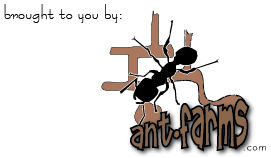Development of an Ant
An ant’s life starts with an egg. A fertilized egg will result to a female ant; otherwise, it would be a male ant. Ants develop by complete metamorphosis, going through the larval and pupal stages before finally becoming adults. Ants during the larval stage are quite helpless and cannot care for themselves. It is during this stage where the difference in class is determined. Feeding in the larval stage would spell the difference whether an ant would become a queen or a worker and what particular type of worker it would be. The process of trophallaxis wherein an ant regurgitates food previously held in its crop for communal storage is the method by which food is given to the larvae. Adult ants distribute food amongst themselves in the same manner. It is important that the larvae and pupae are kept in fairly constant temperatures to ensure proper development. This is the reason why they are often moved around in various brood chambers within the colony.
The first few days of a new worker’s adult life is spent on caring for the queen and the young. Worker ants eventually graduate into digging and other nest work and ultimately to the foraging and defense of the nest. The changes that will occur as to its function are fairly abrupt and define the so called temporal castes. Experts have theorized that ants only participate in foraging when they are older and closer to death because of the high death rate that occurs at this function. There are also ants that are subdivided according to physical castes where they can be classified either as minor, median or major workers depending on their size. Major workers begin foraging sooner than the others. Larger ants often have disproportionately larger heads and thus stronger mandibles. They are sometimes called “soldier” ants because this attribute makes them effective fighters against other creatures. However, they are still considered working ants.
The more common species of ants breed in the same way. The queen and the breeding females are the only ones that have the ability to mate. The drones or the male ants that are born with wings, along with the breeding females, do nothing throughout their life except eat until the time for mating comes. All breeding ants, not including the queen will be carried outside where other colonies of some species are doing the same. All the winged breeding ants take flight as mating occurs in flight. Males die shortly afterwards and the surviving females land and seek a suitable place to begin a colony. They then break off their wings to lay their eggs and take care of them. The sperm obtained from the nuptial flight is stored to be used to fertilize all future eggs produced. The first workers to hatch are weaker and smaller than later workers. However, they serve the colony immediately by enlarging the nest, foraging for food and caring for other eggs. This is how most colonies start. Those with multiple queens are able to start a new colony when one queen takes a number of workers to a new site and creates her own colony.
A suitable nest site would vary from open, sandy areas to soil or trees in dense woodland depending on the species. The queen installs herself in a sealed chamber to lay a small batch of eggs that will hatch as the first group of workers. The queen continues to lay eggs but the responsibility of taking care of them has been passed on to the workers. The queen is the only ant in the nest capable of laying eggs as all workers are sterile.
On a specific time of year, depending on the size of the nest and the temperature among other things, the queen will begin to lay a different kind of egg that will develop into new queens and males. They will wait for the right combination of temperatures and wind and pheromones or chemical messages. The new queen and males will leave this nest and begin the cycle described above.


